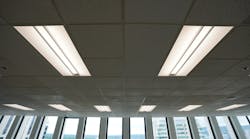Over the last year, returning to offices and schools in a pandemic increased awareness of indoor disease transmission, energy consumption, and overall indoor environmental quality. As we go into 2022, it will remain top of mind as the future of human health indoors has changed forever.
University of Oregon’s Energy Studies in Buildings Lab published a whitepaper in May that explored how Luminaire Level Lighting Controls (LLLCs) have the potential to revolutionize how we monitor and respond to indoor environmental factors that impact human health.
LLLCs have a networked occupancy sensor and ambient light sensor installed for each luminaire kit. The wireless sensors are embedded at the fixture level, which can independently modulate light intensity, apparent color, and spectral distribution through onboard controllers and sensor packages. Since each fixture is capable of sensing and responding to ambient conditions, LLLC systems provide light only where it is needed, saving significant amounts of energy.
Kevin Van Den Wymelenberg is the director at the Institute for Health in the Built Environment, an associate professor at the University of Oregon, and the whitepaper’s author. He published an article about how buildings shape human health earlier this year. For its Ask the Expert series, BetterBricks asked him questions about what makes occupancy sensing stand out with LLLCs. Check out his answers in the video, or read his responses below.
Q. How does occupancy sensing through LLLCs help improve human health indoors?
A. With LLLCs, you have a new sort of data coming from your lighting system that is distributed occupancy awareness.
The onboard occupancy sensor helps guide the fresh air delivery systems so that you’re providing fresh air where and when it is needed and doing it more quickly than other sensor technologies.
Q. What other ways do LLLC sensors help make buildings healthy?
A. The second is through circadian regulation, where the onboard daylight sensor can track what the likely dose is of each occupant in each space in terms of the daylight available and potentially supplement that with the electric light on board or guide users through a hot-desking system to the better-daylit locations.
Q. How do these two things work together?
A. Luminaire level lighting controls are already integrating occupancy sensing with plug strips so that you could turn off unnecessary plug loads. It's connecting with daylight harvesting and therefore dimming the electric light according to the daylight available, and I think that in the future, it could also connect with building ventilation systems so that you provide the fresh air when and where it's needed based upon the distributed occupancy signal from luminaire level lighting control occupant sensors.
BetterBricks, commercial resource of Northwest Energy Efficiency Alliance, helps Northwest building professionals gain a competitive edge in the market. Visit BetterBricks.com for more information.



